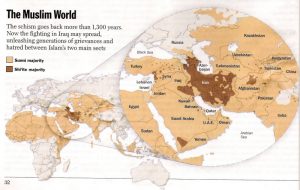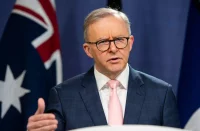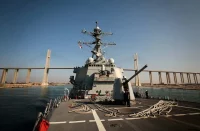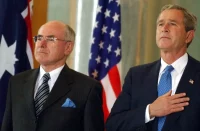– In politics, nothing happens by accident.
If it happens, you can bet it was planned that way.”
―Franklin D. Roosevelt
1950-1978:
Peace has been elusive since I came into political understanding in mid-60s. For three decades following World War 2, superpowers USA and USSR waged ideological wars in the South East Asian Theater. The first military action of the Cold War for global political, military and economic supremacy started in June 1950 between the Soviet-backed People’s Republic of Korea to the north and the pro-Western Republic of Korea to the south. The Vietnam or the second Indo-China war followed in November 1955. By the end of the two wars in 1975, total casualties ranged from 6 to 8 million people. Both wars were fought in vain.
While the Americans were engaged in Far East Asia, pro-Israeli neo-conservatives Henry Kissinger (who successfully disengaged US from Indo-China) and Alan Greenspan seized the opportunity to influence Washington’s foreign and economic policies to favor Israel who was unleashing terror upon the Palestinians by evicting them from their ancestral lands with the intent of building settlements. The Palestinians became homeless and without a state. They took up arms to defend themselves and became branded as terrorists.
Egyptian, Iraqi, Syrian, Algerian, Moroccan and Jordanian Arabs, backed by Soviet support and Saudi and Kuwaiti oil funding, were no match for the highly disciplined Israeli army during the short wars in 1967 and 1973. Egypt, in economic doldrums, was the first Arab country to fall into the American camp lured by economic aid. The others followed.
1979-1990:
The US had to abandon its efforts in Far East Asia and shifted to a new dogmatic, economic, religious and political war in the Middle and Near East regions of Asia involving control of resources, protecting Israel from Arab Muslims and ensuring hegemony of the pastures.
The first major twentieth century conflict between Muslims started between Iran and Iraq from 1980-1988 driven by religious zeal following the Iranian revolution of 1979 when Shias came into power following the revolution. Not only did the Iraqi Sunni Baathists feel threatened but so did the predominantly Sunni Arabs funded by Saudi Arabia. By the end of the war nearly 1 million people had died on both sides.
At the same time that the Iran-Iraq war was raging, the western powers seized the opportunity to form a coalition of Sunni Muslims funded by Saudi Arabia and trained by Pakistan’s army to oust the Soviets from Afghanistan between 1979 and 1990. Afghanistan then plunged into a power struggle between the various tribes after the Soviet withdrawal. The Afghan war also gave birth to religious fundamentalism and state sponsored terrorism in Muslim countries.
1990-THE SEEDS & OBJECTIVES OF THE CIVIL WAR:
The region has witnessed many wars (following the end of the cold war and the end of the Soviet empire) involving western powers and Muslims but with the invasion of Iraq and Arab Spring an American engineered shift has evolved from Sunni to Shia empowerment across Iran to Iraq and from Syria to Lebanon in the shape of an inverted crescent. At the same time, the western powers have been encouraging Saudi Arabia to form a Sunni coalition. The paradigm of a civil war is beginning to take shape.
In a most simplistic statement “the civil war is intended to provide a wall of security for the state of Israel.” This security is only possible if Muslims do not unite. A civil war does not only accomplish that security to ensure the Muslims remain divided but it also provides major economic gains because US is a war economy. The US has been unable to recover from its faltering economy following the great recession of 2008. The American hegemony (or that of any empire) has always rested in its economic bite and as the empire has aged its bite has also weakened.
 For every empire in history there has been a challenger and for the US it comes in the form of China, the second largest global economy. China has succeeded by securing a foothold in the Indian Ocean through Pakistan while also doing so in the eastern Pacific by building artificial islands to support naval and military bases. The US military might has stretched very thinly across the globe just as the Roman empire did across Europe and Asia and by doing so it has weakened.
For every empire in history there has been a challenger and for the US it comes in the form of China, the second largest global economy. China has succeeded by securing a foothold in the Indian Ocean through Pakistan while also doing so in the eastern Pacific by building artificial islands to support naval and military bases. The US military might has stretched very thinly across the globe just as the Roman empire did across Europe and Asia and by doing so it has weakened.
Russia is the second most powerful military force after the US and challenger to the American hegemony and its Eurasian imperatives (borrowed that from Mr. Brzezinski’s book “The Grand Chessboard”). As NATO partners, the EU has been coerced by the US to straddle Russia’s western borders to contain it during the Muslim civil war. As I indicated earlier in the article “How American Lies Have Destabilized Global Regions“, Ukraine crisis in November 2013 was instigated by lies by the US Assistant Secretary of State for European and Eurasian Affairs Victoria Nuland (wife of a leading neo-conservative Robert Kagan) with the geopolitical and economic (sanctions) objectives against Russia.
China and Russia under the SCO (Shanghai Cooperation Organization) umbrella have formed a counter balancing military force against NATO. James Bellacqua has noted in his book “The Future of China-Russia Relations” that they maintain exceptionally close and friendly relations, strong geopolitical and regional cooperation, and significant levels of trade. This stems mainly from American Eurasian hegemony designs.
Iran’s supreme leader Ayatollah Ali Khamenei had cautioned his team of nuclear negotiators that “underneath the US-EU N-deal lies hidden a half nuclear bowl ” and in my subtle understanding he has perceived the Shia-Sunni civil war. The Iranian ayatollahs are learned, not ignorant. It is Iran that is fighting the terrorists, not promoting it. By lifting the various sanctions and oil embargo on Iran, the US is providing Iran with the economic opportunity to prepare for the eventuality.
About the civil war:
- An American or Israeli false flag operation or a misunderstanding between Shias and Sunnis could provoke it. The civil war could start 12-18 months after the US elections
- The Middle East and Near East Asian Muslim regions will all be involved in the conflict with the NATO powers generally supporting Sunni Muslim coalition backed by funding from Saudi Arabia whilst Russia and China support the Shias backed by Iranian funding. NATO will contain the Eurasian region along the Russian border from Ukraine to prevent it from becoming directly involved.
- A plausible scenario might develop leading the Chinese military to either overrun nuclear Pakistan or allow it access to Iran since Pakistan will be joining the SCO as full member in 2017. Turkey and Egypt will undoubtedly support the Sunni Muslims because of their close “Political Islam” (Islam used towards a political end through jihad or holy wars) relationship with Saudi Arabia. Note: The jihad in political Islam is not only waged against non-Muslims but against Muslims as well through state oppression.
- The civil war may prolong for a long time, maybe as long as 5-7 years
- Muslim disunity during a civil war will be a protective shield for Israel.
- The image of Islam has been tarnished but the civil war will aggravate it.
- Oil prices will rise exponentially and the US-EU economies will boom as their defense industry operates at full capacity.
- The Jihadis (religious warriors) will leave Europe and N. America to fight in the civil war thus purging terrorism in North America and Europe.
EPILOGUE
The civil war can be averted if Muslims and specifically Arab leaders get back their sense of lost mental superiority, ignorance and use of Islam for rivalry as well as political and economic gains. The civil war will be an eventuality predominantly conducive for the US imperative and Israeli security. At some point during the civil war the warring factions will come to an understanding and bury their hatchets as did the Europeans following the colonial and world wars. That will be when peace will be no longer elusive.
The views expressed are the author’s own and do not necessarily coincide with one’s of the Editorial Board.














Pingback: The elusive peace and the Great Middle East civil war | Protestation
Pingback: The elusive peace and the Great Middle East civil war | GeoPol Intelligence
Well during the 1967 Israeli aggression, Pakistani volunteer pilots shot-down ten Israeli jets.
https://rehmat1.com/2012/08/17/pakistani-pilots-who-shot-down-10-israeli-jets/
The economies of Greece, Israel, and Turkey were adversely affected by terrorist incidents, and their market shares of tourist trade also fell, with spillover effects for other Mediterranean countries. Terrorist acts and large-scale violence during 1960-93 hurt bilateral trade flows in a large number of countries.
Pingback: What civilizations are to clash in the Great War? | Oriental Review
Pingback: What civilizations are to clash in the Great War? | Réseau International (english)